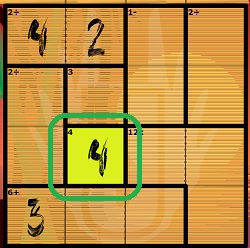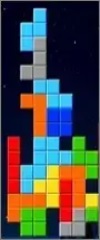KenKen Mathdoku Challenge - Play Free

KenKen, also known as Mathdoku or Calcudoku, is a math logic puzzle similar to Sudoku.
This game is part of the free online brain games collection.
To begin, click the Small, Medium, or Large button under the picture of the game. This opens the game in a pop-up window.
If you like this number puzzle game, you might enjoy the other free math games on this site, such as online Sudoku.
KenKen Mathdoku Game - Instructions
Note: The instructions below are for the old Adobe Flash game.
Follow simple rules to calculate the appropriate numbers for the grid.
The mathdoku puzzles in this game are available in many sizes, from 4x4 up to 10x10 grid. If you've never solved one before, start with the 4x4.
Note: The game file is large, so it might take a moment or two to load in the pop-up window.
This mathdoku games includes the four basic math operations of addition, subtraction, multiplication, and division. See below for tips on how to solve kenken puzzles, including an instructional video.
HOW TO PLAY. After the game pop-up opens, wait a few moments for the game to load. This displays the Mathdoku Challenge main menu.
Click the Play Game button to display a list of available grid sizes.
The goal of kenken is to fill out the grid with numbers, using the math operator (addition, subtraction, multiplication, or division) provided for each subsection.
As in sudoku number puzzles, in kenken you can only enter a number once in each row or column. So for a 4x4 grid, the numbers 1,2,3, & 4 can only be entered once in each row and column in the grid.
The areas enclosed by a thick border are called "cages". Within each cage is displayed the math operator you need to use to solve that cage.
Hint: If there are any single-cell cages in your puzzle, enter these first. In the example below, there is a single cell with a "4" displayed in the upper left of the cell.

Single Cell in a KenKen puzzle
This means a 4 is the correct entry (the only possible entry) for that cell.
However most of the cages will have two or more cells. For instance, you see a two-cell cage with a "3+" displayed in the upper left corner of the cage.
This means you need to enter two numbers (one in each cell) that add up to 3. Zero (0) is not a valid number in mathdoku puzzles, so in this example you'd need to enter a 2 in one of the cells and a 1 in the other cell (2 + 1 = 3).
More examples: A three-celled cage with "12x" means you need to enter three numbers that when multiplied by each other equal to 12. A two-celled cage with "1-" indicates you need to enter two numbers that equal 1 when they are subtracted.
GRID SIZE SELECTION. The grid selection screen displays the different available kenken board sizes. The 4x4 (Very Easy) option is a mathdoku grid four cells wide and four cells high. This is the easiest size to solve.
Clicking a grid size displays a blank kenken puzzle board of the selected size. Each board is divided into cells which have either a light border or thick border.
KenKen (Calcudoku) Walk-through Tutorial
(For a helpful tutorial on how to solve mathdoku puzzles, see the 4 minute video at right.)
To enter a number in the grid, first click the cell where you want the number to appear. Next, click the number from the number list on the right side of the game screen. The number you selected then displays in the cell.
To remove a number from the grid, click the cell to highlight it. Then click the 'X' button on the right side of the grid.
This Mathdoku Challenge game has a built-in error checking feature.
Whenever you happen to make an entry that causes a number to display twice in the same row or column, or if the calculation with the operator is factually incorrect, the background of one of the numbers glows red.
For instance, if you enter 4 - 2 = 1 in a cage (which, of course, is not a correct subtraction fact), a red background displays to alert you of your error.
The error checker doesn't give away the answer. If a cell is currently blank, the background doesn't change. This feature simply points out conflicts that violate the basic kenken rules.
Mathdoku Game - Options
There are a few other useful options in this Mathdoku Challenge game: Mute, Timer, Background Off, and Hint.
To mute the background music, click the speaker icon in the upper right. An automatic timer displays in the upper right so you can track how long you've been working on the puzzle.
To change the background of the puzzle board from bamboo to plain white, click the White BG Off button in the upper right.
If you're accustomed to playing on paper, or if your vision isn't the best, you might prefer the white background. It helps the numbers stand out better.
The Hint feature is useful although a bit of a cheat. Clicking the Hint button displays one of the missing numbers in the puzzle.
You can actually click the Hint button repeatedly and solve the entire puzzle.
Note: Once a puzzle is solved, a Complete! message displays. If you want to return to the Mathdoku Challenge main menu to solve another kenken puzzle, click that message.
A red screen then appears, with a Done button in the lower left. Click the Done button to display the main menu.
The game of KenKen was invented by Tetsuya Miyamoto, a Japanese math teacher. Play this game regularly to strengthen your arithmetic ability and logical reasoning skill.
Published: 04/29/2010
Last Updated: 06/11/2020

Newest / Popular
Multiplayer
Board Games
Card & Tile
Concentration
Math / Memory
Puzzles A-M
Puzzles N-Z
Time Mgmt
Word Games
- Retro Flash -
Also:
Bubble Pop
• Solitaire
• Tetris
Checkers
• Mahjong Tiles
•Typing
No sign-up or log-in needed. Just go to a game page and start playing! ![]()
Free Printable Puzzles:
Sudoku • Crosswords • Word Search







